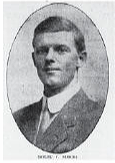October 5, 2023


Samuel F. Perkins lived at 14 Rockmere St. He invented the man-carrying kite and continued experimentation on his creation from 1910 through the first World War and into the 1920s.
Perkins demonstrated his kites and skills at aeronautical exhibitions across the country. At the 1910 Harvard-Boston Aero Meet in Squantum, “he demonstrated that a man can be sent 2,000 feet in the air, supported by from 5 to 6 large 18-foot passenger-carrying aeroplane war kites.” (The Boston Globe, Dec, 14, 1912).
In 1912, he received an order for 25 kites from Lt. John Rodgers of the USS. Nebraska, which was docked at the Charlestown Navy Yard. Rodgers was the foremost researcher in the use of man-carry kites for the U.S. Navy.
The following is taken from a Facebook posting: “The principle was simple. A lead kite, eighteen feet high, was flown into the sky to test the wind. If conditions were right, a series of six to seven stringer kites would follow until there was enough lift to raise a man. A ground crew operating a winch could reel the “pilot” in or out depending on the weather, or what he needed to see.
“Perkins may have been misguided, but he was not seen as a crackpot. He attended Harvard and MIT. The US Army Signal Corps and the US Navy expressed serious interest in his invention as a means of observing the enemy. Admiral Richard Byrd even took a Perkins kite on one of his Antarctic expeditions.
“The biggest issue was stability. Getting a Perkins kite into the air was easy, but if wind conditions changed, the kite could veer out of control. Perkins learned this the hard way during a test flight when he fell 150 feet to the ground. Nevertheless, he not only survived, but he also remained undeterred.
“The US wasn’t the only country to experiment with kite observation systems; Germany and France employed them on a regular basis during World War I. However, it soon became clear that using a kite for observation was nothing more than a heroic investment in white elephant technology, and once again kites became the playthings of children.”



